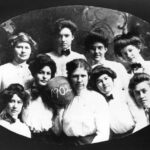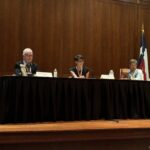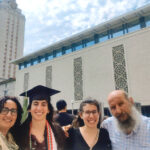A Historian Reflects on Frank Denius and the Power of UT’s Regents Room

Frank Denius, LLB ’49, Life Member, Distinguished Alumnus, and I were well acquainted when we began collaborating on the book that became his life’s story, On The Way: My Life and Times, published by the Briscoe Center for American History in 2016. In casual encounters throughout almost three decades, we had talked about World War II, Texas politics, and The University of Texas—topics that comprise about two-thirds of the book. When we began concentrating on the book in 2013, he was eager to talk. Eventually I had transcripts of more than 30 hours of private conversations, just the two of us sitting together in his office. In all that time, Frank uttered not one vulgar or profane word, although I suspect he was tempted when he recounted how OU coach Barry Switzer spied on Darrell K Royal’s preparations for their game in 1976 by disguising an assistant coach as a groundskeeper.
Frank was not judgmental, but he took a jaundiced view of Switzer attending Royal’s memorial service more than 25 years later.
As drafts of chapter manuscripts emerged from my computer, we met regularly over lunch and in his office to discuss them. Each recollection led to others, seeming to push further into his lucid memory, drawing on a rich well of long-buried experiences. He called me frequently with new revelations and reflections that made an incident or period more transparent, like his law firm’s sub rosa operating philosophy—espoused by his wily senior partner Edward Clark, ’28, Distinguished Alumnus—to “own” a congressman (LBJ), a bank (Capitol National), and have a close relationship with the news media (KTBC). Others might be a memory of crossing the Rhine on a rubber pontoon bridge at night through a heavy smokescreen, or the sheer fun of working with Jake Pickle at the 1960 Democratic National Convention.
“We want to be respected on the playing fields, but we must always be No. 1 in ethics.”
Frank was a throwback to an earlier age when our patriotic spirit was undiluted, purer and simpler—the kind he learned as a boy in his hometown of Athens, Texas, walking around the courthouse square on Armistice Day (as Veterans Day was called until 1954) or the Fourth of July. His conversation was sprinkled with patriotic inferences: “Freedom is not free;” “Each generation must pay a price for its freedom;” and “Success depends on the ability to manage fear, whether on the battlefield, in the courtroom, or the boardroom”—and he knew all three abundantly.
He spoke often of values and ethics, both personally and in awarding grants from his family foundation, the Effie and Wofford Cain Foundation, and of the analysis and reflection that was required to make wise decisions. He also spoke of the importance of values in everything involving The University of Texas: “We want to be respected on the playing fields,” he would say, “but we must always be No. 1 in ethics.” Such casual comments finally led me to respond, “There’s a lesson in what you’re saying for those who come after us.” I suggested that we make it part of our book. In an instance, he bolted upright in his chair and blurted out, “It’s there in the Regents Room.” He was referring to the handsome chamber in UT Austin’s Main Building that was designed for formal university functions and meetings of the UT System Board of Regents when it was built in the 1930s.
Now called the “Jamail Room,” after Lee Jamail for the gift that she and her husband, Joe, made for its renovation in 2009, the room soars majestically upward through two stories, peaking at its vaulted ceiling, and inspiring awe and admiration. Aside from its elegance, the room leaves lasting impressions for its floral decorations in gold leaf and gilded inscriptions on the ceiling, quoting the ideals and hopes of UT’s leaders in its formative years. Both Frank and I had long been inspired by the aphorisms about knowledge, education, and the university in the room. When he was legal counsel to the Regents in the 1960s, they usually met there, and I had attended countless gatherings of university committees in the same location.
Although thoroughly familiar with the Jamail Room, I wanted to go there again, alone, but with Frank in mind, before I wrote about it for the book. The next morning, I got there before business hours, let myself in, and sat alone in the august ambience as the soft light of early morning filtered through the lush grayish gold silk draperies. I made notes on the glistening inscriptions for later discussion with Frank. H.Y. Benedict, president of the university from 1927 until he died in office in 1937, stated a truism that those in authority would do well to remember in their every deed: “Public confidence is the only real endowment of a state university.” As a person of faith, Frank resonated with regent A.W. Terrell’s saying that “Those who serve best both God and country are those who wisely instruct youth.” Even in ordinary conversation, Frank often cited these words from the state constitution that are found there—“The Legislature shall establish, organize, and provide for the maintenance, support, and direction of a University of the first class.” For him, those 20 words were a mandate for UT and its supporters to strive for excellence in all endeavors.
And he well understood that those endeavors require money in ever-increasing amounts, whether for teaching, research, public service, or intercollegiate athletics, with which he is prominently identified. His enthusiastic support for football is better known than his generosity with academic programs, but his monetary gifts—and those he arranged with other donors—for academics exceeded his gifts to athletics. He and his wife, Charmaine, supported numerous scholarships awarded by the Texas Exes, and he substantially endowed the Normandy Scholar Program enabling students to study WWII, including visiting where it was fought in Europe. One of his last gifts, in 2015, was a $10 million Cain Foundation endowment to Dell Medical School, for which he was a fervent advocate from 1954 until it became a reality in 2013.
The inscriptions in the Jamail Room affirm that UT is not a for-profit corporation but an educational institution whose success is measured in the achievements of its former students. He noted that this is true for all students, even if they make football their vocation, as Tom Landry did. For his conduct, integrity, and achievements during his playing years, wartime service, and as the coach of the Dallas Cowboys, Frank considered Landry a model for all Longhorn athletes.
In September 2015, while returning from lunch, we decided to refresh our familiarity with the exterior of the Tower. We parked on the north side near the Tower Garden and walked completely around it, slowly contemplating the whole arena. He considered the height and splendor of the Tower an expression of the university’s aspirations to fulfill its constitutional mandate. On the east and west walls we observed the names of great thinkers—Shakespeare, Milton, Aristotle, and others—who explained and framed the classics of Western civilization and the names of the earliest universities in Europe and United States, along with the University of Mexico, the oldest university in North America. On the east side we stood, gazing at architectural decorations on the cornice under the eaves of Garrison Hall: bluebonnets, cacti, a steer’s head, the university seal, and more than 30 cattle brands, the heraldry of ranchers like Charles Goodnight, Sam Maverick, José Antonio Navarro, and George Littlefield, whose monetary gifts helped fund the construction of the Main Building and Tower.
On the south side of the Main Building, we paused on the great plaza as Frank described fall registration in 1946, the year after he returned from the war, which took place along the base of the steps of the building. He got in line at about 6 a.m., and by 9 a.m., some 17,000 students were standing in lines that extended to 19th Street (MLK Boulevard). Two years before, UT’s enrollment had been fewer than 9,000. Now campus was flooded with thousands of new students, former students, and veterans like Frank drawing benefits under the GI Bill. Frank got extra money each month because he had been wounded. He called it “walk around money” and used it to buy civilian clothes to replace his Army khakis.
Completing our stroll around the Tower, Frank mused, “This is a sacred place,” and expounded on his belief that the Regents Room was a good starting place to acquaint newcomers with the value system of our university. If he had his way, he said, every new student or employee would have a short course on the high ethical standards—“the exceptionalism”—of The University of Texas that would begin with the inscriptions of the Jamail Room, which for him remained until his death this July, “the old Regents Room.”
Photo courtesy Texas Athletics














No comments
Be the first one to leave a comment.